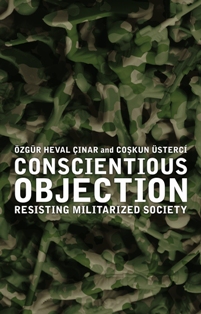Conscientious Objection

Global Resistance
Conscientious Objection: Resisting Militarized Society
Edited by Özgür Heval Çınar and Coşkun Üsterci
Zed Books, 2009, 268 pages, $35.95
In January 2007, an international conference on conscientious objection was held at Istanbul Bilgi University. More than 300 people participated during the two days of the conference, and special attention was paid to the gender aspects of militarism. Resulting from this conference are the 23 short essays that constitute Conscientious Objection, more a reference handbook than a narrative account. Essays are organized into four main categories: resisting conscription; conscientious objection as a critique of patriarchy, sexism, and heterosexism; experiences and problems with conscientious objection in the world; and the law around conscientious objection.
Special emphasis is placed on the deplorable situation in Turkey, where the constitution states that “national service is the right and duty of every Turk.” There is no legal recognition of objectors and no provision for alternative service. A small number of objectors claimed exemption from military service based on sexual orientation. Gay men (women are not conscripted) are considered mentally ill and must prove their claims to the authorities by providing photographs of their homosexual activities. If the government accepts a claim, the man is given a “rotten report,” which brings with it job discrimination and social ostracism.
However, a growing peace movement sponsored several events to make itself visible, actions which are considered criminal. One imaginative approach to publicizing Turk antimilitarism and resistance was the 2004 Militourism Festival in Istanbul, with participants visiting and poking fun at “militarist, nationalist institutions, monuments and rituals encountered every day in the streets of the city.” The protest also led to a discussion of the role of women in the movement. The festival’s success led to similar events in following years.
The essays differ in importance, and there is some repetition concerning the situation in Turkey. Although much is included about the legal status of objectors in various countries, there is little explanation of the way provisions are implemented. Much of the chapter on conscription in the United States is based on information from the open-source online encyclopedia Wikipedia, some of which is incorrect. A reader would learn very little about the World War II draft, for example, and a clear description of the differences among resisters who were imprisoned and those who were in civilian public service is missing. A reference to current recruiting practices states that “the military will continue to tap new sources of recruits such as homosexuals and foreign nationals.”
One of the most interesting chapters is “A View on International Implementation of the Right to Conscientious Objection.” The fact that 27 countries have no armed forces astonishes, although some are very small and little known, at least in the United States. Of the United Nations’ 192 members, 168 have military forces, with more than 15 percent recognizing conscientious objection as a right. As well we know, the United States is not one of them; here, conscientious objection is considered a privilege in practice, if not in law.
In an era of globalization, it is encouraging to see international pressure for protecting the right of conscience coming from such sources as the United Nations and the Council of Europe. The emergence of antiwar and even pacifist movements in virtually every nation is certainly a hopeful sign for a future without war.
